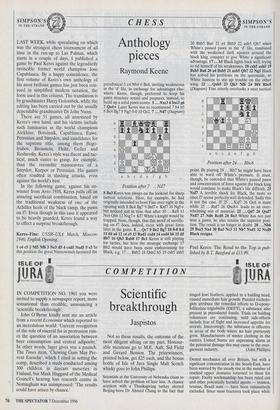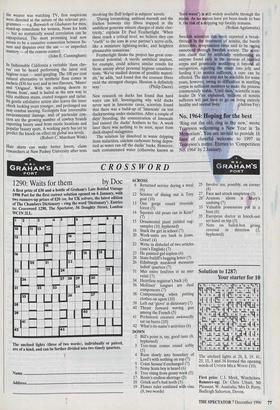ISLE OF 111, J SINGLE Yk1.I N.UICH WW1
URA
ISLE OF
JURA
SINGLE MALI SCOICH ‘HISICI
COMPETITION
Scientific breakthrough
Jaspistos
IN COMPETITION NO. 1961 you were invited to supply a newspaper report, more sensational than credible, announcing a 'scientific breakthrough'.
John O'Byme kindly sent me an article from a recent Economist which reported to an incredulous world: 'Current recognition of the role of visceral fat in protrusion rais- es the question of an association between beer consumption and central adiposity.' In other words, lager gives you a paunch. The Times item, 'Chewing Gum May Pre- vent Earache', which I cited in setting the comp, described a study conducted among 300 children in daycare nurseries in Finland, but Mark Haggard of the Medical Council's hearing loss research centre in Nottingham was unimpressed: 'The results could have arisen by chance.' Not so these results, the outcome of the most diligent sifting on my part. Honour- able mentions go to M.E. Ault, Sid Field and Gerard Benson. The prizewinners, printed below, get £25 each, and the bonus bottle of Isle of Jura Single Malt Scotch whisky goes to John Phillips.
Scientists at the University of Nebraska claim to have solved the problem of hair loss. A chance accident with a Thanksgiving turkey alerted Beijing-born Dr Ahmed Chang to the fact that singed fowl feathers, applied to a balding head, caused immediate hair growth. Puzzled tricholo- gists attribute the remedial effects to D-epoxy- follicolate-triglobulin (DEFT), a substance also present in pterodactyl fossils. Trials on balding volunteers are continuing; mild side-effects include fear of flight and increased appetite for cereals. Interestingly, the substance is effective in areas of the body where no hair previously grew. Manufacturers of winter clothing in the eastern United States are expressing alarm at the potential damage this may cause to the over- garment industry. (John Phillips) Dental mechanics all over Britain, but with a signficant concentration in the South-East, have been worried by the steady rise in the number of cracked upper dentures returned to them for repair. Faulty workmanship has been ruled out and other potentially harmful agents — tension, tetanus, Brazil nuts — have been exhaustively excluded. Since most fractures took place while
the wearer was watching TV, first suspicions were directed at the nature of the relevant pro- grammes — e.g. Baywatch or Gladiators for men, stand-up comedians for women, News for both — but no statistically sound correlation can be extrapolated. The most promising lead now seems to be a causative connection between fis- sure and disputes over the use — or imperfect mastery — of the remote control.
(John E. Cunningham) In fashionable California a veritable 'dune cho- rus' can be heard performing the latest oral hygiene craze — sand-gargling. The 100 per cent natural alternative to synthetic floss comes in sachets ($30 for ten) and in two flavours, `Minto' and 'Original'. With 'six exciting deserts to Choose from', sand is hailed as the new way to blitz stubborn stains, coated tongues and tartar. Its gentle exfoliative action also leaves the inner cheek looking years younger, and prolonged use may combat snoring. Ecologists fear irreversible environmental damage, and of particular con- cern are the growing number of cowboy brands exporting luxury sand from exotic locations and Popular beauty spots. A worlcing party has yet to predict the knock-on effect on global sea-levels. (Robert C. Marchant Wink) Hair shirts can make better lovers, claim researchers at New Pudsey University after tests involving the fluff lodged in subjects' navels.
'During lovemaking, ambient warmth and the friction between tiny fibres trapped in the umbilicus generate minute charges of static elec- tricity,' explains Dr Paul Featherlight. 'When these reach a critical level, we believe they can "earth" to the ions in your partner's nerve-cells, like a miniature lightning-strike, and heighten pleasurable sensations.' Featherlight thinks the project has great com- mercial potential. A sterile umbilical implant, for example, could achieve similar results for those uneasy about personal hygiene considera- tions. 'We've studied dozens of possible materi- als,' he adds, 'and found that the coarsest fibres yield the strongest charges. Hessian is definitely sexy.' (Philip Dacre) New research on ducks has found that hard water can kill. Investigating why wild ducks never nest in limestone caves, scientists found that there was a build-up of 'limescale' on test ducks nesting under stalactites. After a couple of days' brooding, the concentration of limescale had caused the ducks' feathers to fur. A week later there was nothing to be seen, apart from duck-shaped stalagmites.
The solution lay dissolved in water dripping from stalactites, calcium carbonate being depos- ited as water ran off the ducks' backs. However, such contaminated water (otherwise known as 'hard water') is still widely available through the mains. As no moves have yet been made to ban it, the risk of a dripping tap fatality remains.
(Rohan Agalawatta) Swedish scientists this week reported a break- through in the treatment of nonitis, the barely detectable, symptomless virus said to be raging unnoticed through Swedish society. The scien- tists claim that by artificially synthesising an enzyme found only in the corneas of startled coypu and genetically modifying it beyond all recognition, injecting the result into jelly and feeding it to nonitis sufferers, a cure can be effected. The cure may not be available for some years, however, owing to difficulties in startling coypu in sufficient numbers to make the process commercially viable. 'Until then,' scientific team leader Dr Vlee explained, 'millions of nonitis sufferers will just have to go on living entirely healthy and normal lives.' (Adrian Fry)
No. 1964: Hoping for the best
'Ring out the old, ring in the new,' wrote Tennyson welcoming a New Year in 'In Memoriam'. You are invited to provide 16 lines of cheerful welcome to 1997 in Tennyson's metre. Entries to 'Competition No. 1964' by 2 January.



















































































 Previous page
Previous page